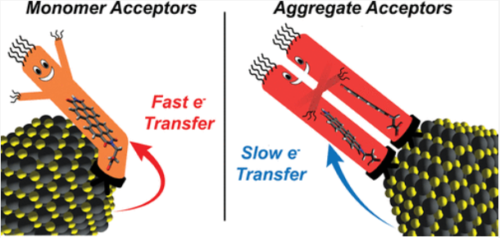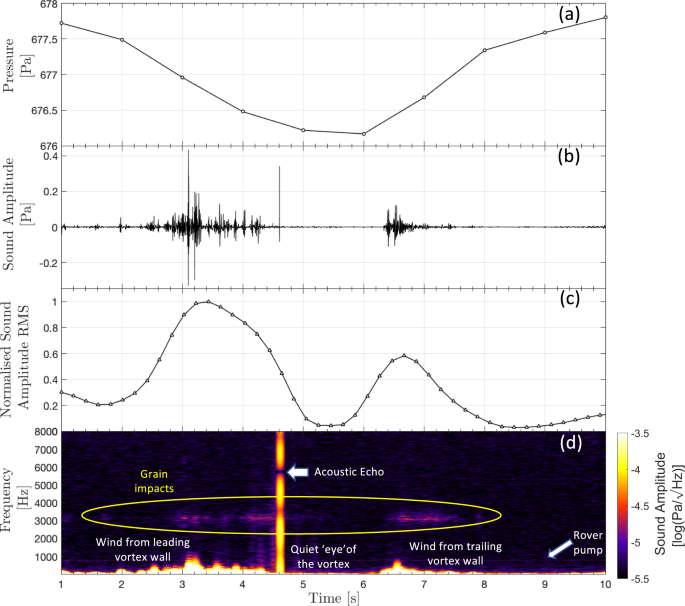電荷受容体の添加により、一部の光活性化材料で電子移動が遅くなることが判明 Adding charge acceptors can slow electron transfer in some light-activated materials
2023-01-04 ライス大学
ハイブリッドナノ材料は、有機成分と無機成分を組み合わせることで、光の捕獲、検出、変換、制御を独自の方法で行うことができる。ハイブリッドナノ材料への関心は高く、ハイブリッドナノ材料に関する科学論文は過去20年間で10倍以上に増えている。例えば、従来の太陽光発電パネルでは見逃されていた赤外線などの波長からエネルギーを取り出すことで、太陽光発電システムの効率を向上させる可能性がある。
この材料を作るには、化学者が光捕捉半導体のナノ結晶と、配位子として働き半導体表面に付着してナノ結晶から電子を運び出す「電荷受容体」分子を結合させる。
「最もよく研究されているナノ結晶システムは、半導体結晶に直接結合した高濃度の電荷アクセプターを備えています」と、ライス大学の化学者ピーター・ロスキー(Journal of the American Chemical Society誌の共同執筆者)は言う。「一般に、人々は、電荷受容体の表面濃度を最大化しようとします。それは、表面受容体濃度とともに電子移動速度が連続的に増加することを期待しているからです。
これまでにも、表面アクセプターの濃度に応じて電子移動速度が上昇し、その後、表面濃度が上昇し続けると低下するという実験結果がいくつか発表されている。Rosskyと共同研究者のSean Roberts(カリフォルニア大学オースティン校化学准教授)は、リガンドの分子軌道が電荷移動に影響を与えるような相互作用をすることがあることを知っており、結晶表面にさらにリガンドを詰め込むと、そうした相互作用を引き起こすポイントがあるのではないかと予想したのである。
このアイデアを検証するため、CAFFのロスキー、ロバーツ教授らは、硫化鉛ナノ結晶と、ペリレンジイミド(PDI)というよく知られている有機色素の濃度を変化させたハイブリッド材料を系統的に研究した。その結果、ナノ結晶表面のPDI濃度を上げ続けると、最終的に電子移動速度が急激に低下することがわかった。
Rossky氏によると、この挙動の鍵は、PDI分子間のリガンド-リガンド相互作用が、結晶表面上のPDI凝集体の形状に及ぼす影響であるという。こうした凝集効果の影響を示す証拠をまとめるには、各研究グループの専門知識が必要であり、分光実験、電子構造計算、分子動力学シミュレーションを慎重に組み合わせる必要があった。
Roberts教授は、「今回の結果は、電荷分離のための光活性化ハイブリッドナノ結晶材料を設計する際に、リガンド-リガンド間の相互作用を考慮することの重要性を示しています。私たちは、リガンドの凝集が、ある状況下では電子移動の速度を確実に低下させることを示しました。しかし、興味深いことに、我々の計算モデルは、リガンドの凝集が、他の状況下では、電子伝達を速めることもできると予測しています」。
ロスキーは、ライスのハリー・C・アンド・オルガ・K・ヴィース自然科学講座で、化学と化学・生体分子工学の両教授です。
<関連情報>
- https://news.rice.edu/news/2023/more-links-arent-necessarily-better-hybrid-nanomaterials
- https://pubs.acs.org/doi/10.1021/jacs.2c09758
ナノ結晶表面における電荷受容体の凝集が光誘起電子移動の速度を変化させる Aggregation of Charge Acceptors on Nanocrystal Surfaces Alters Rates of Photoinduced Electron Transfer
Danielle M. Cadena, Jakub K. Sowa, Daniel E. Cotton, Christopher D. Wight, Cole L. Hoffman, Holden R. Wagner, Jessica T. Boette, Emily K. Raulerson, Brent L. Iverson, Peter J. Rossky and Sean T. Roberts
Journal of the American Chemical Society Published:November 30, 2022
DOI:https://doi.org/10.1021/jacs.2c09758

Abstract
Semiconductor nanocrystals (NCs) interfaced with molecular ligands that function as charge and energy acceptors are an emerging platform for the design of light-harvesting, photon-upconverting, and photocatalytic materials. However, NC systems explored for these applications often feature high concentrations of bound acceptor ligands, which can lead to ligand–ligand interactions that may alter each system’s ability to undergo charge and energy transfer. Here, we demonstrate that aggregation of acceptor ligands impacts the rate of photoinduced NC-to-ligand charge transfer between lead(II) sulfide (PbS) NCs and perylenediimide (PDI) electron acceptors. As the concentration of PDI acceptors is increased, we find the average electron transfer rate from PbS to PDI ligands decreases by nearly an order of magnitude. The electron transfer rate slowdown with increasing PDI concentration correlates strongly with the appearance of PDI aggregates in steady-state absorption spectra. Electronic structure calculations and molecular dynamics (MD) simulations suggest PDI aggregation slows the rate of electron transfer by reducing orbital overlap between PbS charge donors and PDI charge acceptors. While we find aggregation slows electron transfer in this system, the computational models we employ predict ligand aggregation could also be used to speed electron transfer by producing delocalized states that exhibit improved NC-molecule electronic coupling and energy alignment with NC conduction band states. Our results demonstrate that ligand aggregation can alter rates of photoinduced electron transfer between NCs and organic acceptor ligands and should be considered when designing hybrid NC:molecule systems for charge separation.




